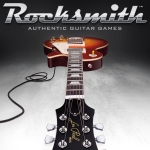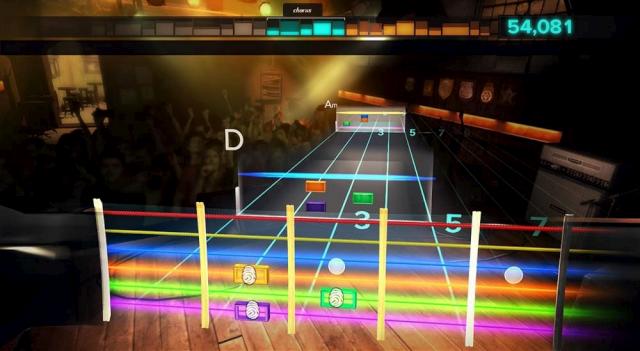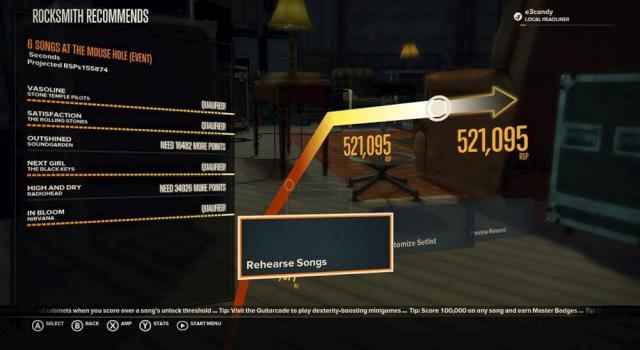
For a few years the console music scene was in full flow, with titles being released from the Rock Band and Guitar Hero series seemingly every few weeks. And yet the time came when the bubble burst and we suddenly saw nothing more from either side of the music fence. Plastic guitaring, drumming and keyboarding was kept up to date by plenty of regular DLC, but the games themselves seemed to have hit their peak with the brilliant Rock Band 3. People needed something a bit new, a bit different. Some time later and Rocksmith has joined the party, dropping the fake instruments in favour of strapping on a real guitar or bass and rocking out in style.
The best thing about previous music games was the accessibility, giving pretty much everyone a chance to take part in a few songs using equipment that had an approximate likeness to those used by the rock gods on stage. Rocksmith aims for a very different audience though, and whether you’re looking to learn the guitar, improve your current skills or just want chance to play along to some great songs (more on the top quality set list later) there’s something for pretty much everyone, although the needle does lean more towards the beginners end of the scale. Losing this insta-rock accessibility isn’t a bad thing, Rocksmith isn’t trying to be Guitar Hero after all, and it opens up a whole new set of options.
Using the adapter found in the box, the first thing you’ll need to do is connect up your guitar to the console, which will then do a straight forward job of helping you get tuned in and ready to go. From here there are a few options, letting you choose how you’re going to start your instrumental career. If you’re getting started then the Techniques section is the place to be, teaching you how to do pretty much everything on your chosen instrument, from holding the guitar and plectrum through to bending notes and bashing out new chords and riffs. Beyond that you can practise your new-found skills using the Guitarcade (some good punnage right there) which gives some fun and highly addictive mini-games to challenge your use of scales, harmonics and other such skills. Alternatively if you just want to rock out to the songs on offer then you can dive straight in and do just that, or even use your TV as an amp by using some of the built-in effects pedals, unlocked as you do a decent job through some of the songs.

But the most comprehensive option is the Journey mode, effectively a career option which lets you pick up songs bit by bit in rehearsals before unleashing yourself on an audience. The songs tweak themselves dynamically, so as you improve and perform better the difficulty goes up, and vice versa if you’re struggling. This means that apart from some sudden difficulty jumps you’re generally always playing at your own level, and although this is slightly flawed (which I’ll go into later) it’s an interesting twist on the difficulty setting theme.
The aforementioned track list is fantastic if a little light, managing to pretty much eliminate the usual problem of only wanting to play half the songs included. Featuring tracks from Sound Garden, Radiohead, Muse and Queens of the Stone Age amongst others it’s one hell of a collection, and will give both beginners and reasonable guitarists plenty of opportunities to flex their fingers and play like a hero. This obviously means you’re far more likely to stick with it for long enough to hit the higher scores and unlock more pedals to play with and venues to perform in, and with a positive amount of DLC this should continue for a fair amount of time yet.
There are other nice touches too – being able to decide which way round the strings show up on the screen is incredibly handy if you’re used to seeing things a certain way, and when a song needs different tuning (such as a drop-D tuning on a guitar or an entire semi-tone retune on the bass) it’ll help you retune without needing to worry about whether you’re heading in the right direction.

So it’s a very positive package, but not without its issues. Beginners might find the difficulty to spike quite considerably once they start getting the hang of things, and while wanting to just keep it at a set level could end up getting frustrated by the changing difficulty. Also starting up for the first time takes an age, with a sound check and never-seen-a-guitar-before intro that shows you the very basics and can’t be skipped, even if you’re the next John Squire. It’s a tiny thing that could easily have been changed, but there’s no avoiding it.
So as a learning tool, Rocksmith does well. It pushes a bit too hard at times, but takes things easy and teaches you techniques as well as how to actually play the songs. Being able to use a guitar or bass is brilliant and makes it more accessible for those with a 4-string preference, and it’ll even let you emulate a bass by using the bottom 4 strings of a regular guitar (which, if you’re not aware, are tuned to the same notes as a bass) so you can have a go at bassing without forking out for a second instrument. At the other end of the scale it gives experienced guitarists a chance to play along and challenge themselves with some great songs, although there probably isn’t as much to keep you here if you already take a regular jump onto the stage to wow your local pub.
It is, however, expensive to get going. If you’re not already in possession of a guitar that’ll set you back a bit (or you can buy the game bundled with a guitar if you prefer), but if you’re planning on learning anyway then the extra price of the game isn’t too far from a couple of books that would just show you the chords and leave you to strum along to the radio.
Whether you’re new to the guitar scene or want to show off your skills, Rocksmith will do a very decent job of entertaining and teaching you. It’s not the perfect package, and it’s definitely not a party game in the same vein as Rock Band or Guitar Hero, but it’s impressive never the less. An very worthwhile debut, that’s for sure.
Reviewed on PS3


Leave a Reply